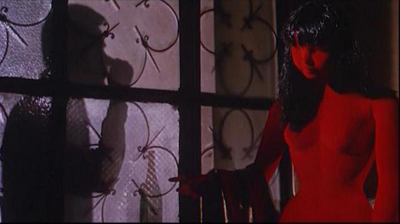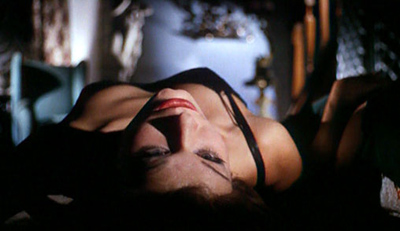Blood and Black Lace/Review
From The Grindhouse Cinema Database
< Blood and Black Lace

The pulpy plot of 'Blood and Black Lace' - a mysterious killer slaughters the beautiful models of a haunted-house-like fashion salon - is not the most important aspect of Mario Bava's masterpiece, although the title accurately indicates its interest in (female) death and (fetishistic) sexuality. Indeed, Bava seems to freeze the potentialities for terror and suspense in favour of hermetic set-pieces, where the elaborate mise-en-scene, its colours, lighting effects, set-design and the composition of figures within it, the European bande dessinee chic, are all far more important than any psychological crises the characters undergo. Indeed, the loving way Bava films the mannequins that strew the salon, the glowing red light that shines from some, or the curved wires of others, betrays more intense interest than in any of his human figures.
With one exception: the murderer, a faceless, bandaged figure in black sunglasses, dark raincoat and trilby, a Fantomas for the more lurid 1960s, poised arbiter of aestheticised transgression, a figure who shares with the director the power to be everywhere, see everything and decide the fate of the characters. 'Blood' is not a generic thriller or horror film, but the blinding epitome of pop-art Surrealism, where the guiding spirits are the likes of Man Ray, Ernst, Cocteau and Franju, where the image is composed and fragmented into static, fetishistic components, where decor and atmosphere and look are manipulated with rarefied perversity.
We may not care about individual characters, but the look of the film as a whole, its charged shards of images, its staged restructuring of generic form, its invasively creepy camera movements, with its point-of-view shots that don't belong to anyone, together unleash a full-blown expression of our most profound and inadmissable desires, impulses, dreams, fears; our most murderously (misogynistically?) violent wishes; our eroticising of death; our terror of the unknown, the random order of death and the decay of beauty, the failure of our attempts to preserve it. Crucially, the proliferation of murders are an attempt to keep the truth hidden, just as the unconscious spills out of any attempt to repress it.
Bava is credited in films like this with inaugurating the slasher genre, but at its inception he fearsomely negates its ideological, helpless-female/predatory-male assumptions (which is why many horror fans can't deal with him), although to tell you how would spoil your enjoyment of this Jacobean nightmare.
Reviewed by Biohazard
References
1. Lucas, Tim. Blood and Black Lace DVD, Image Entertainment, 2005, liner notes. 2. Lucas, Tim. Mario Bava All the Colors of the Dark, Video Watchdog, 2007.




















